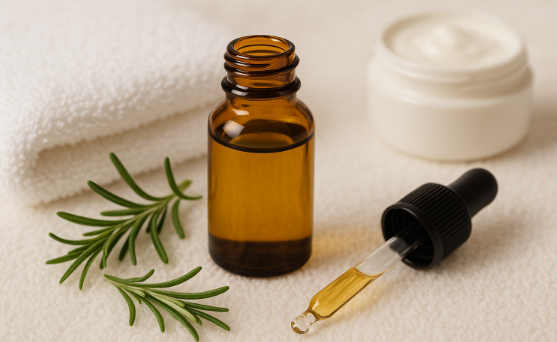
B25023 I By Lara Campbell, PharmD Class of 2026, ACP
Is Rosemary the Real Deal for Skin Healing? Here’s What the Research Says
Rosemary (Rosmarinus officinalis) has long been valued in traditional medicine for its aromatic, anti-inflammatory, and wound-healing properties. Now, modern clinical trials are validating these claims, especially for conditions like seborrheic dermatitis, episiotomy wound care, skin regeneration, and oxidative skin stress, which occurs when there’s an imbalance between free radicals (unstable molecules) and the skin’s ability to neutralize them with antioxidants.
This blog summarizes clinical and laboratory-based studies supporting the use of rosemary-based topicals in dermatology and wound care.
What the Science Says
How It Works
Rosemary extract is derived from the leaves of Rosmarinus officinalis, typically via steam distillation or solvent extraction. Its main therapeutic compounds include:
- Carnosic acid & rosmarinic acid – Antioxidant and anti-inflammatory; reduce reactive oxygen species (ROS) and inflammatory cytokines
- 1,8-Cineole & α-pinene – Improve circulation, combat bacteria and fungi, and support tissue oxygenation
Mechanisms of Action:
- Inhibits inflammation and oxidative damage at the cellular level
- Stimulates collagen synthesis and fibroblast proliferation for faster healing
- Reduces itching and microbial growth on the skin
How to Use It: Topical Forms & Dosing
| Form | Typical Strength | Suggested Use |
| Rosemary lotion | 5% | Apply a thin layer to the affected area 1–2 times daily |
| Rosemary cream | 3% | Use twice daily on healing wounds or post-surgical sites |
| Diluted essential oil | 1–2% dilution in a carrier (e.g., jojoba) | Use a small amount on localized skin areas 3–4x/week |
| Scalp oil/shampoo | 0.1–1% in hair oil or shampoo | Massage into scalp, leave for 15–30 mins, rinse 2–3x/week |
⚠️ Always patch test before widespread use. Essential oils must be diluted—never use undiluted rosemary oil on skin.
Side Effects and Safety
- Generally safe when diluted and used topically
- Undiluted rosemary oil may cause skin irritation or allergic reactions
- Patch test recommended, especially for sensitive skin
- Pregnancy/Breastfeeding: Consult with a provider
- Pets: Toxic if ingested or absorbed—do not apply rosemary oil on or near cats/small dogs
Final Thoughts
Topical rosemary extract is supported by modern clinical and laboratory studies showing its ability to accelerate wound healing, reduce oxidative stress, soothe inflammation, and fight microbes. Rosemary oil, with its anti-inflammatory, antimicrobial, and antioxidant properties, may help manage acne, calm redness and puffiness, improve skin tone and texture, and support anti-aging by stimulating circulation and protecting against oxidative damage.
References
- Sadati MS, Alesana F, Hekmat M, Parvizi MM. Efficacy of topical rosemary extract lotion versus topical 2% ketoconazole lotion in the treatment of seborrheic dermatitis: a double-blind randomized controlled clinical trial. Dermatol Pract Concept. 2024;14(4):e2024242. doi:10.5826/dpc.1404a242
- Hadizadeh-Talasaz F, Mardani F, Bahri N, Kheirkhah F, Saadati N, Yazdanpanahi Z. The effect of rosemary cream on episiotomy wound healing in primiparous women: a randomized placebo-controlled trial. BMC Complement Med Ther. 2022;22(1):226. doi:10.1186/s12906-022-03675-1
- Hekmat M, Parvizi MM, Sadati MS. Antibacterial and wound healing potential of rosemary extract: an in vitro and cellular evaluation. New Pharm Tech. 2021.
- Duthie GG, Gardner PT, Morrice PC, et al. Effects of plant extracts on antioxidant status and oxidant-induced stress in Caco-2 cells. Br J Nutr. 2010;104(9):1324-1331. doi:10.1017/S0007114510002143
Acknowledgment:
This blog was prepared with assistance from ChatGPT by OpenAI. The featured image was also created with the help of AI tools.
Note:
This content is for informational purposes only and is not intended as medical advice. Always consult your healthcare provider before starting any supplement.
Share Your Experience
Have you ever used this supplement? We’d love to hear your story!
✅ Did it help?
⚠️ Any side effects?
💊 What dosage and form did you use?
Your comments help others and contribute to a growing database of real-world evidence.
Thank you for sharing!
